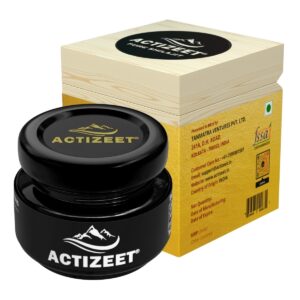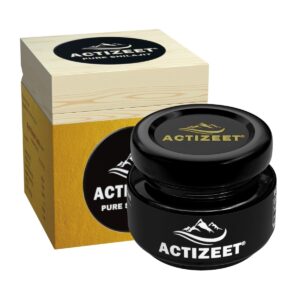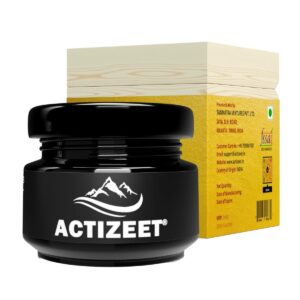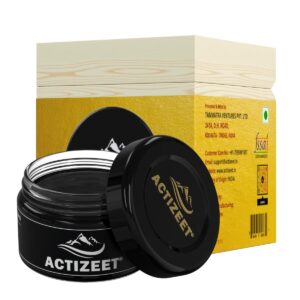Shilajit is very similar to other humic substances found in soil because it is composed of about 60-80 percent humus – however, after thousands of years and under exact conditions found at high altitudes, these substances undergo a profound change, transforming into the wonderful pure product ready for human consumption that we all know and love today.
Table of Contents
ToggleShilajit composition and a complete list of Shilajit components.
Natural processes over hundreds of thousands of years produce high-quality Shilajit in a few of the world’s oldest mountain ranges from organic matter at extremely high altitudes.
As a result, some people mistake Shilajit for mineral pitch, asphaltum, ozokerite, or even a petroleum-based product similar to mineral oil, but it’s none of those things.
Shilajit differs from the above-mentioned substances in that it is made from natural carbon and contains an impressive list of organically derived elements, as opposed to being entirely made up of inorganic materials.
Shilajit is similar to other humic substances found in soil because it contains about 60-80 percent humus; however, after thousands of years and under exact conditions found at high altitudes, these substances undergo a profound change, transforming into the wonderful pure product ready for human consumption that we all know today.
Beneficial plant alkaloids, amino acids, healthy fat, resins, waxes, and many other natural compounds with beneficial health effects make up the rest of Shilajit that isn’t made up of humic and fulvic acids.
Full list of elements and organic products present in Shilajit:
- Albumen
- Alumina
- Amino acids (cysteine, lysine, alanine, histidine, arginine, aspartic acid, glycine, glutamic acid, serine, tyronine, threonine, proline, tyrosine, methionine, leucine, valine)
- Barium
- Benzoic and fatty acids
- Beryllium
- Bismuth
- Calcium
- Carbon-60
- Chromium
- Cobalt
- Copper
- Dibenzo-alpha-pyrones
- Gallium
- Gold
- Hippuric acid
- Humic and fulvic acids
- Hydro-oxidized primary and secondary amide peptide bonds
- Iron
- Lead
- Magnesium
- Manganese
- Molybdenum
- Nickel
- Phenolic steroids and pregnane steroids
- Phospholipids
- Phosphoric anhydride
- Potassium
- Resins and plant remains
- Silicate groups of silicon dioxide
- Silver
- Small quantities of strontium oxide
- Sodium
- Sulfur
- Tin
- Titanium
- Vanadium
- Wax
- Zinc
This list of elements is roughly the same across all types of Shilajit, with slight differences in the ratios of each depending on the geographical origin.
Shilajit from the Caucasus Mountains, for example, contains more iron, copper, and manganese than Central Asian varieties.
In the Himalayas, four types of Shilajit have been studied, primarily based on their nutrient ratios: red (gold), blue (copper), white (silver), and black (iron). The colors refer to the color of the ores in and around which the Shilajit is found, with fractionally more of that mineral present in the Shilajit (eg. red Shilajit comprises a bit of bit extra gold than different varieties).
Scientists have spent a significant amount of time testing various types of Shilajit to see if this mineral content material has any distinct advantages. Some of the outcomes are perplexing, particularly amongst various teams of Indian scientists, each of whom appears to have a strong opinion about which one is the best.
Fortunately, the vast majority of these trials conducted throughout Asia have demonstrated that each Shilajit provides nearly identical positive health results. Low altitudes, heat exposure, and poor preservation are the only exceptions to this understanding, all of which reduce efficiency.
Shilajit composition: Chemical & Empirical Components of Shilajit
Fact is informed, Shilajit doesn’t have a standard chemical formula as of yet.
Since the composition of all of the minerals differs barely from area to area, it is troublesome to create a common equation. To not point out, the fulvic acid portion of Shilajit makes it nearly inconceivable, as no one may inform you what the chemical system for fulvic acid itself is!
Whereas this can be the case relating to the chemical system, a basic empirical system was suggested by R. G. Yusupov in 1979 :
CaSi(KNa)C25H57O26
+
C6H6O3
Shilajit Melting Level & The Effects of Temperature
Shilajit has a melting level of 80°C/176°F. That is one way to inform it other than faux substances like ozokerite, the melting level of which is ±73-76°C/164-169°F.
When Shilajit is heated up for extended durations of time, it begins to denature and subsequently loses a few of its useful elements and results. From a purist’s perspective, Shilajit ought to by no means be heated or boiled past 65°C/150°F and it is really helpful to course of it even at decreased temperatures to totally protect its nutrients.
Sadly, most manufacturers will warmth it as much as 70°C/158°F for a restricted time at some level throughout processing to convey it to a desirable consistency. This partially destroys a number of the lively components, however, it will nonetheless present a number of the immense health advantages Shilajit provides. Heating over the melting level will completely denature the substance, effectively “burning” it.
If positioned in a fridge or saved at low temperatures, Shilajit resin begins to harden and turns brittle. Dropping a chunk of chilly Shilajit on the ground will shatter it! Whereas cooled all the way down to this extent, it additionally gains a sheen that it lacks when at room temperature. It is best to be capable of softening a chunk of chilly Shilajit resin within the palm of your hand with ease.
Water & Oil Solubility
Shilajit has an exceptionally excessive affinity for water and is ready to dissolve readily in water, whether or not at room temperature or heated.
Most of the natural minerals in Shilajit are present in salt type, which imparts hygroscopic properties much like that of salt. For instance, should you go away open a bag of fine high-quality shilajit for 1-3 days, it is going to begin to attract moisture from the air and clump collectively.
Shilajit doesn’t dissolve into the oil as it does in water, nevertheless, it does naturally include a small portion of fatty acid parts. In resin type, one can simply combine it into an ointment.
Not surprisingly, Shilajit additionally has surfactant properties. This means that it lowers the surface pressure of water, making it simpler to combine different substances into the water. Surfactants are generally utilized in family cleansing brokers to interrupt the floor pressure of stains, though this won’t work within the case of Shilajit as it is going to make a lot larger stain of its own!
Recommended Shilajit
-
Himalayan Shilajit, Pure shilajit, Shilajit, SHUDDH SURYA TAPI SHILAJIT
Rated 4.74 out of 5₹4,950.00Original price was: ₹4,950.00.₹3,950.00Current price is: ₹3,950.00. Incl. GST ADD TO CART Buy Now -
Himalayan Shilajit, Pure shilajit, Shilajit, SHUDDH SURYA TAPI SHILAJIT
Rated 4.78 out of 5₹9,900.00Original price was: ₹9,900.00.₹6,450.00Current price is: ₹6,450.00. Incl. GST ADD TO CART Buy Now -
Himalayan Shilajit, Pure shilajit, Shilajit, SHUDDH SURYA TAPI SHILAJIT
Rated 4.74 out of 5₹3,450.00Original price was: ₹3,450.00.₹2,450.00Current price is: ₹2,450.00. Incl. GST ADD TO CART Buy Now -
Himalayan Shilajit, Pure shilajit, Shilajit, SHUDDH SURYA TAPI SHILAJIT
Rated 4.81 out of 5₹8,400.00Original price was: ₹8,400.00.₹5,450.00Current price is: ₹5,450.00. Incl. GST ADD TO CART Buy Now
Related posts:
- Best Shilajit: How To find Best Quality Shilajit
- Which Shilajit Is The Best?
- Can Shilajit Be Taken In Summer?
- Proven And Tested Shilajit Benefits For Men
- Actizeet Shilajit as an Antioxidant Dynamo
- ACTIZEET Shilajit Reviews
- Shilajit Unveiled: Harnessing its Natural Power for Optimal Body Composition and Weight Management
- What is Actizeet Shilajit?







